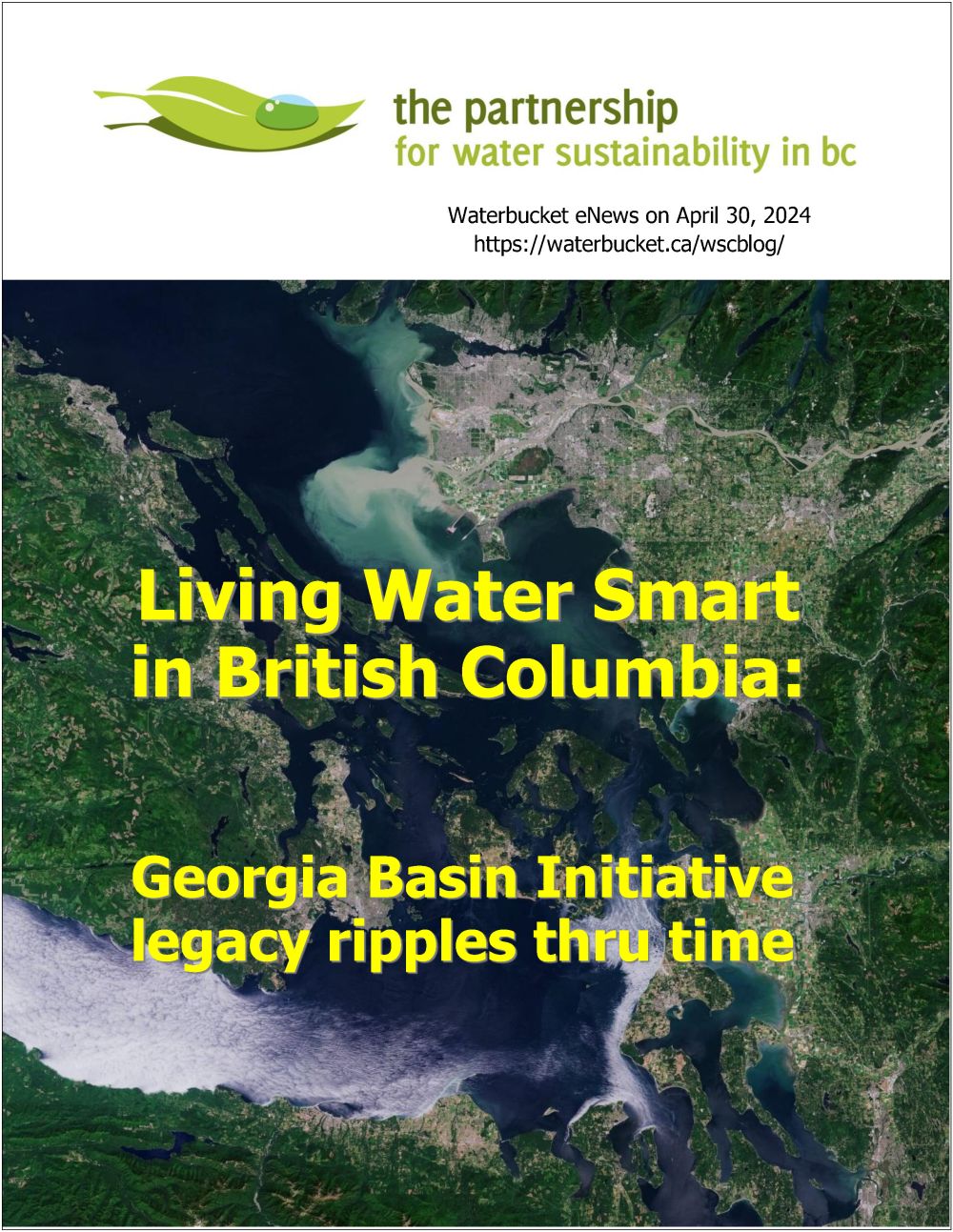GEORGIA BASIN INITIATIVE LEGACY RIPPLES THROUGH TIME: “If we have lost anything in the last 30 years, it is a strong provincial commitment to supporting community and regional planning,” stated Joan Sawicki, land and resource management champion, and former provincial cabinet minister
Note to Reader:
Published by the Partnership for Water Sustainability in British Columbia, Waterbucket eNews celebrates the leadership of individuals and organizations who are guided by the Living Water Smart vision. The edition published on April 30, 2024 features Joan Sawicki and her “story behind the story” of the genesis and early years of the Georgia Basin Initiative in the 1990s. The edition is dedicated to Darlene Marzari, former BC Ministry of Municipal Affairs, and champion of community and regional planning. Darlene Marzari was the single most important reason for the success of the Georgia Basin Initiative, says Joan Sawicki.

Georgia Basin Initiative legacy ripples thru time
“Launched in 1994, the Georgia Basin Initiative was a call to action by the provincial government led by Premier Mike Harcourt. The influence of the Georgia Basin Initiative has rippled through time in profound and lasting ways. In 2024, we celebrate the 30th anniversary of a watershed moment in BC history,” stated Kim Stephens, Waterbucket eNews Editor and Partnership Executive Director.
“Within a few years, the Georgia Basin Initiative led to a federal-provincial agreement to collaborate under the umbrella of the Georgia Basin Ecosystem Initiative. The first 5-year plan covered the years 1998 through 2003. The Georgia Basin Action Plan, an evolution of the GBEI, then covered the second 5-year period from 2003 through 2008.”
“The living legacy of the Georgia Basin Initiative is embedded in and embodied by the current Georgia Basin Inter-Regional Educational Initiative. Led by the Partnership for Water Sustainability and supported by five regional districts, the IREI is now in Year 13 and provides peer-based education among local governments.”
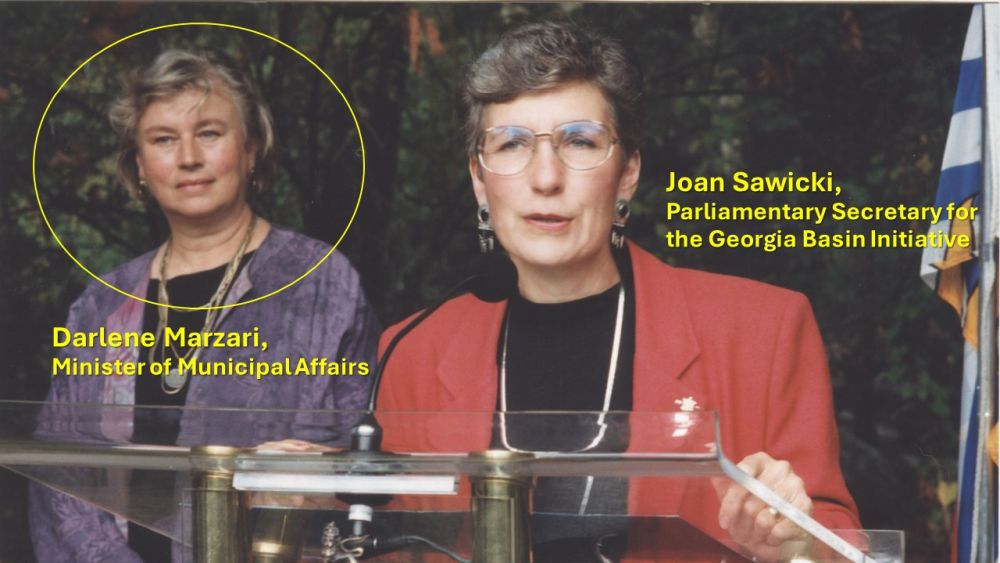
Joan Sawicki and Darlene Marzari at the announcement for the Urban Salmon Habitat Program at Deer Lake in Burnaby, 1995
STORY BEHIND THE STORY: a conversation with Joan Sawicki
“It is important to understand the political environment at the time,” stresses Joan Sawicki.
“The 1980s was a pretty stagnant period in terms of positive government initiatives related to land use and natural resource management. But there were rumblings of discontent; it manifested itself most directly with growing concern over the logging of old growth forests.”
The Brundtland Commission introduced a new idea called ‘sustainable development’

“The Georgia Basin Initiative was a deliberate attempt to do that. Change policies and institutions.”
“The Brundtland Commission introduced this alternate world of so-called ‘sustainable development’. And it talked about protecting 12% of the land base. Think about that! Now people are talking 30 and even 50 percent but at that time 12% was a real shocker!”
“There was a key point that really resonated with me and that was this idea that…structurally, we set up our governments in vertical silos – like Forests, Health, Environment, Economic Development – but ecosystems exist horizontally as integrated systems.”

With the change of government in 1991, land use planning was front and centre
“Upon election in late 1991, Premier Mike Harcourt gave the recently appointed BC Round Table on the Environment and the Economy a new mandate. In late 1993, they submitted Georgia Basin Initiative: Creating a Sustainable Future.”
“With a strong Minister of Municipal Affairs, Darlene Marzari, the ‘settlement side’ of land use planning went straight into regional planning and the Growth Strategies Act.”

“A long-time planner with the ministry, Erik Karlsen was a key ingredient. He not only had the passion and understanding for this stuff and was way ahead of his time, but he also had an unparalleled network of connection with Georgia Basin communities – and, most importantly, a high degree of trust with those communities.”
When top-down meets bottom-up…
“In my experience, governments tend to work in one of two modes. It is either crisis management, when something happens and government has to ‘do something’…or at least be seen to be doing something. Or, at the other end, governments produce lofty, visionary reports and announcements that, while suitably aspirational, too often sit on the shelf unable to be implemented.”
“That is just the reality of human nature. That includes the gap that often exists between what the public say they want in the long-term and what they demand or will accept in the short-term.”

“As Parliamentary Secretary, I had a visionary document and strong personal support from Minister Marzari at the top. And I had Erik Karlsen’s on-the-ground connections with Basin communities and their issues. All I had to do was run with it. And that’s what we did! “
“The Georgia Basin Initiative was successful because we had the right people at the right time doing the right thing. How rare is that in government?”
So, what did the Georgia Basin Initiative actually do?
“There was a clear understanding and consensus on the challenges – that the Georgia Basin was one of the most ecologically diverse regions and also one of the most threatened.”
“There was trouble in paradise. All communities knew they were under intense pressures and that we had to do something about it.”
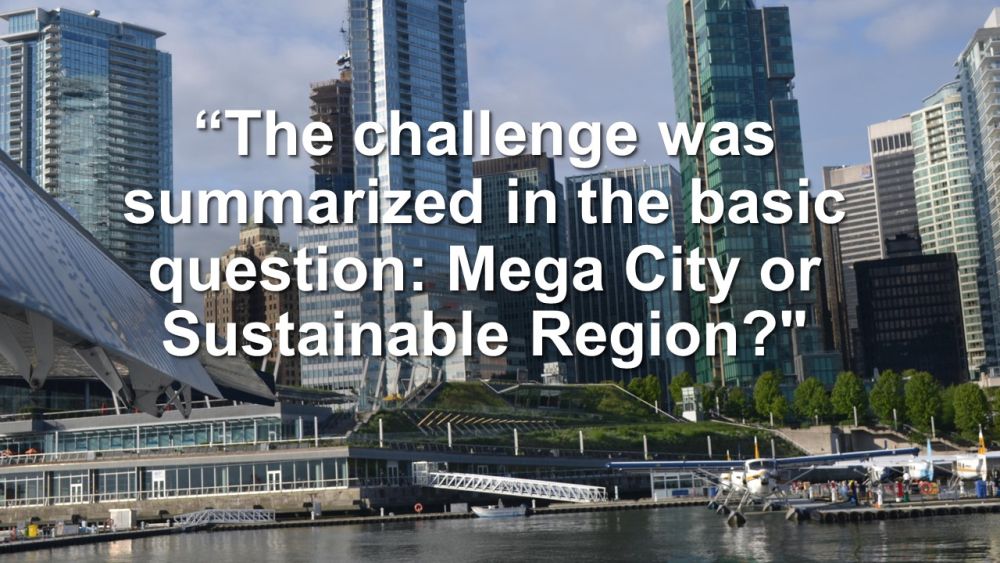
The mandate was work with everybody:
“But, we also had been given a clear vision along with sustainability principles. Much of that came from the Round Table’s work. It also fed into and from Darlene’s Growth Strategies Act for regional planning.”
“Erik and I were told that the intent of the Georgia Basin Initiative was to be both proactive and reactive. That was our job. Just get out there. Talk to all the stakeholders. Find out what was needed. Work with everybody, including cross-border because it was bioregional thinking.”
“Darlene Marzari was a very astute minister; she sent us out there but she did not just cut us loose. She demanded clear work plans. And accountability, with regular report backs, etc. So, the Georgia Basin Initiative was an entity that had it all from top to bottom.”
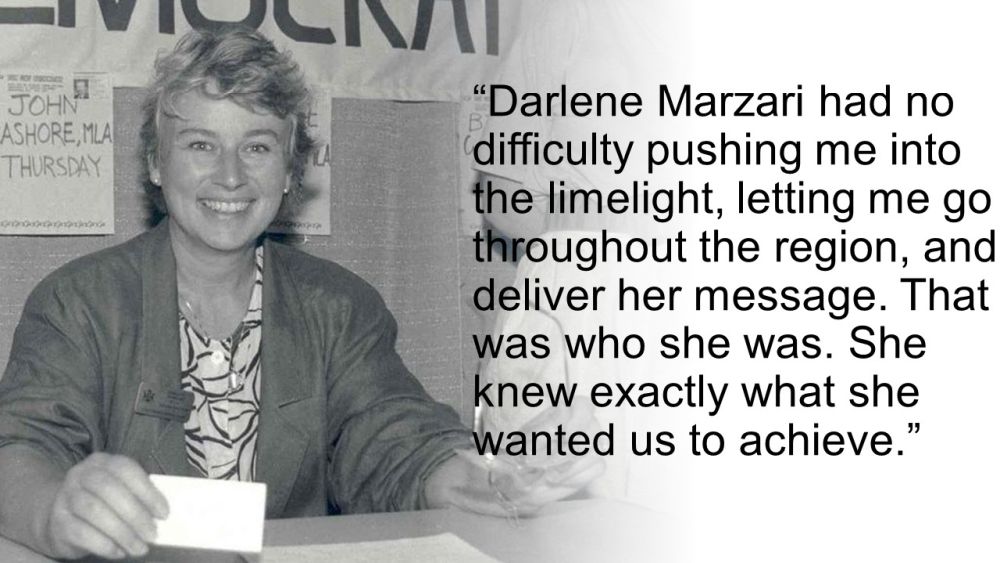
Because conversations lead to dialogue which in turn will lead to consensus
“Most of my work was just going out to Basin communities. Talking and listening to everybody and everything. Raising public awareness. Erik set that all up. He had his fingers in almost every pie.”
“I often felt like a travelling preacher spreading the gospel of bioregional thinking throughout the Region. When I look back at the number of workshops, conferences, and meetings we attended…no wonder we were exhausted! It was a very fast-paced couple of years.”
“We tried not to come empty-handed. We had a small grants program. Erik Karlsen pinpointed the best projects that the Province could support. When communities told us they needed some planning tools, we worked on that. We put out newsletters so that people in the Region could learn from each other…and some of those programs could grow.”
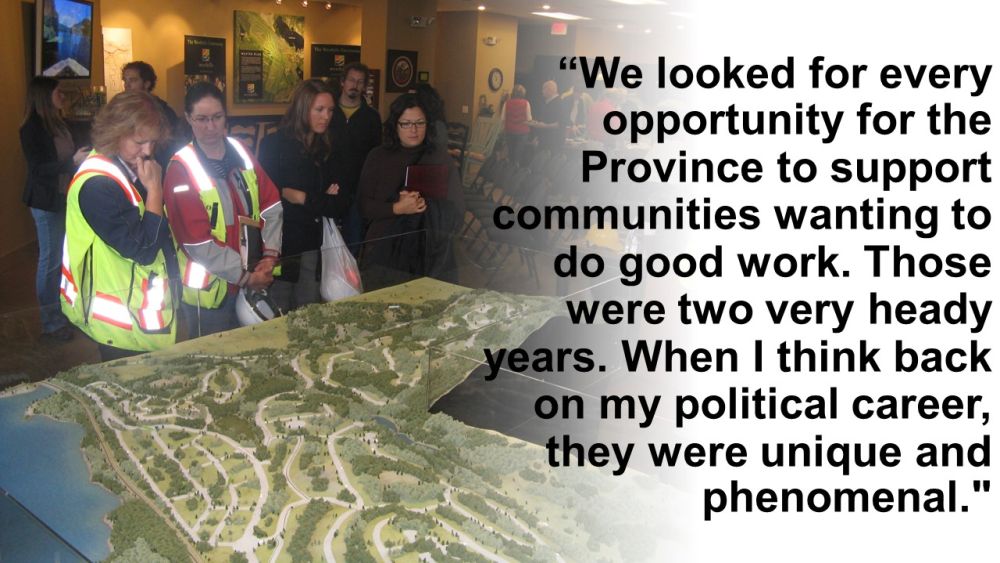
And so, the GBI spawned a movement
“The Georgia Basin Initiative did not survive the 1996 election as a stand-alone entity. There were lots of reasons for this.”
“We had a new premier with a new mandate. Darlene did not run again and, after re-election, I was given a new assignment. But the thinking behind the GBI continued. The seeds had been sown. And they flourished.”
“When you think of other initiatives, like Urban Salmon Habitat Program in 1995; the Fish Protection Act in 1997; riparian protection regulations, The Stewardship Series; Salmon in the City; Fraser Basin Council, Georgia Basin Ecosystem Initiative.”
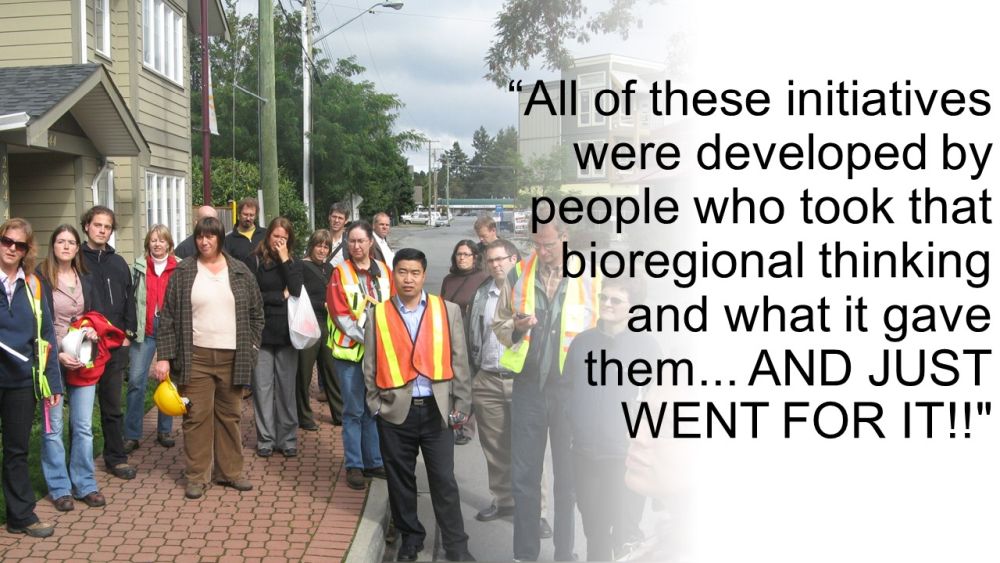
“The Fish Protection Act itself did not fall out of the sky. It too had a story. The Georgia Basin Initiative and the Round Table work were part of the story that allowed the Fish Protection Act to come into being – because people had come to understand the critical role of fish habitat and healthy streams as indicators of local and regional sustainability.”
“When you peel back the skin of the Fish Protection Act, the Urban Salmon Habitat Program not only raised awareness, it reflected what people in communities were saying. Sometimes things just come together. And when they do, WOW! Those times are not very common.”
“If I were to identify the single most important reason for the success of the Georgia Basin Initiative, I would say it was Darlene Marzari. If we have lost anything in the last 30 years, it is a strong provincial commitment to community and regional planning.”
The single most important reason for the success of the Georgia Basin Initiative
|
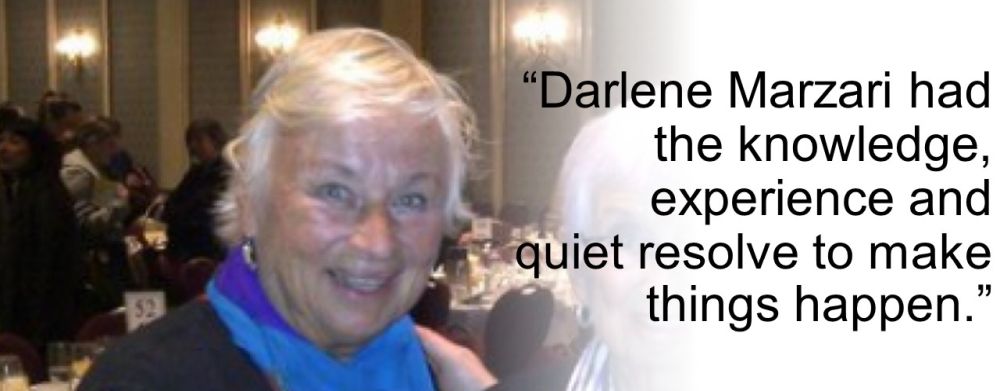
Will another Darlene Marzari emerge, and when?
“When you think of the issues we face today….weather extremes, drying rivers, degraded streams, frequent wildfires, population growth, housing affordability…they are no different than they were 30 years ago. They are just more complex and more urgent.”
“WE NEED A RENEWED PROVINCIAL EMPHASIS – and yes, that means budget – ON SUPPORTING COMMUNITY AND REGIONAL PLANNING. AND WE NEED ANOTHER DARLENE MARZARI,” concludes Joan Sawicki.
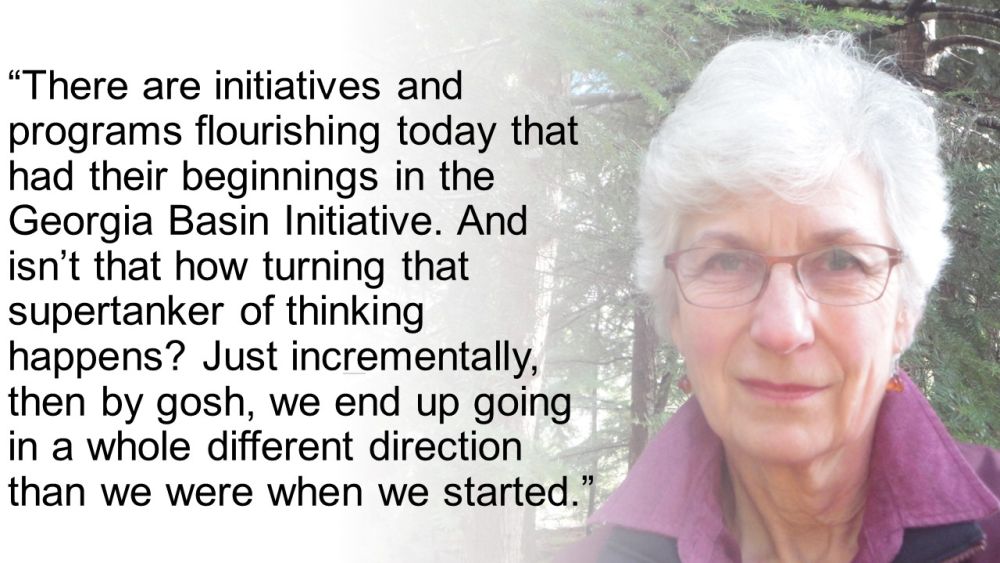
TO LEARN MORE:
To read the complete story, download a copy of Living Water Smart in British Columbia: Georgia Basin Initiative legacy ripples thru time.
DOWNLOAD A COPY: https://waterbucket.ca/wcp/wp-content/uploads/sites/6/2024/04/PWSBC_Living-Water-Smart_Joan-Sawicki-and-Georgia-Basin-Initiative_2024.pdf


